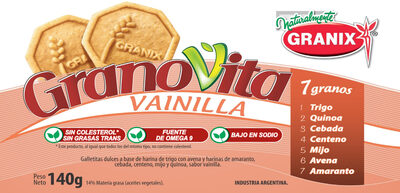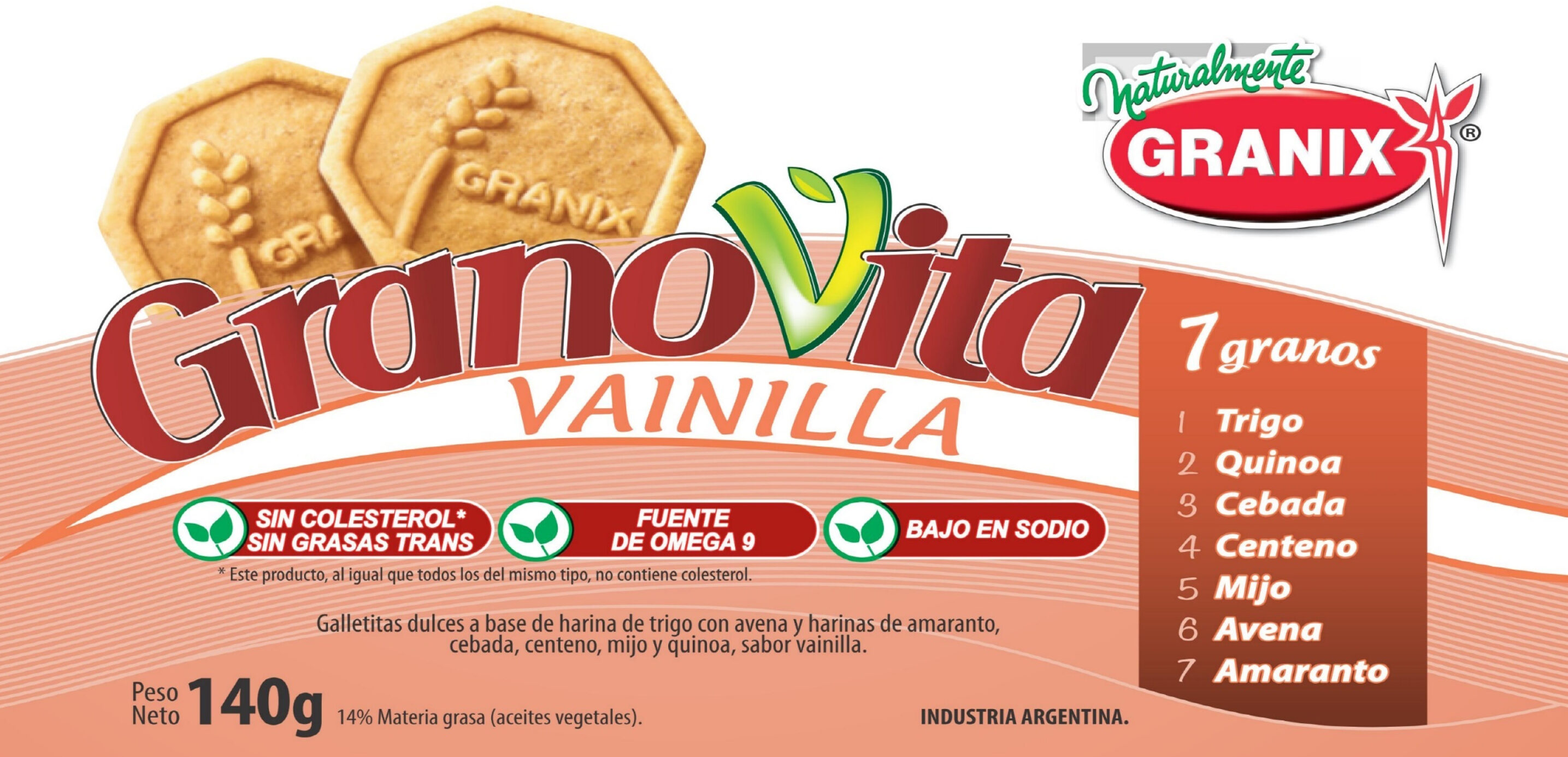Ajuda'ns a fer que la transparència alimentària sigui la norma!
Com a organització sense ànim de lucre, depenem de les vostres donacions per continuar informant els consumidors de tot el món sobre tot allò què mengen.
La revolució alimentària comença amb tu!
GranoVita Vainilla - Granix - 140 g
GranoVita Vainilla - Granix - 140 g
Codi de barres: 7790045000853 (EAN / EAN-13)
Nom comú: galletitas dulces a base de harina de trigo con avena y harinas de amaranto, cebada, centeno, mijo, quinoa, sabor vainilla.
Quantitat: 140 g
Empaquetament: Plàstic, PP 5 - polipropilè, en:Bag
Categories: Snacks, Aperitius dolços, Galetes i pastissos, Galetes, en:Dry biscuits, en:Oatmeal cookies
Etiquetes, certificacions, premis: Baix o sense sodi, Baix en sodi, Sense colesterol, Sense greixos Trans, es:Omega-9
Origen dels ingredients: Argentina
Llocs de fabricació o processament: Baradero, Buenos Aires, Argentina
Codi de traçabilitat: RNE 02-030.790, RNPA 02-588971, 040503190004, CNPJ 53.135.232/0001-13, A-AR-16-07536, A 114279, RE 800016131/1, RSPA 51964, IMSRA 556/159
Enllaç a la pàgina del producte en el lloc oficial del productor: https://granix.com.ar/producto/?idProd=4...
Països on es va vendre: Argentina, Bolívia, Brasil, Xile, Costa Rica, Equador, Panamà, Paraguai, Puerto Rico, Espanya, Uruguai
Matching with your preferences
Salut
Ingredients
-
26 ingredients
: Harina de trigo enriquecida (hierro 0.0030%, niacina 0.0013%, vitamina B1 0.00063%, ácido fólico 0.00022%, vitamina B2 0.00013%), azúcar rubio, aceite de girasol de alto oleico, jarabe de maíz, almidón de maíz, miel, avena arrollada, harina de amaranto, harina de cebada, harina de centeno, harina de mijo, harina de quínoa, salvado de trigo, leudante químico (bicarbonato de amonio), regulador de la acidez (bicarbonato de sodio), aromatizante natural de vainilla, aromatizante natural de manteca, antioxidante (tocoferoles).Al·lèrgens: en:Gluten, en:Sulphur dioxide and sulphites, es:avenaRastres: en:Soybeans
Processament d'aliments
-
Aliments ultra processats
Elements que indiquen que el producte està al grup 4 - Aliments i begudes ultraprocessats:
- Ingredient: Aromes
Els productes alimentaris es classifiquen en 4 grups segons el seu grau de processament:
- Aliments no processats o mínimament processats
- Ingredients culinaris processats
- Aliments processats
- Aliments ultra processats
La determinació del grup es fa en funció de la categoria del producte i dels ingredients que conté.
Additius
-
E307 - Α-tocoferol
Alpha-Tocopherol: α-Tocopherol is a type of vitamin E. It has E number "E307". Vitamin E exists in eight different forms, four tocopherols and four tocotrienols. All feature a chromane ring, with a hydroxyl group that can donate a hydrogen atom to reduce free radicals and a hydrophobic side chain which allows for penetration into biological membranes. Compared to the others, α-tocopherol is preferentially absorbed and accumulated in humans.Origen: Wikipedia (Anglès)
-
E500 - Carbonats de sodi
Sodium carbonate: Sodium carbonate, Na2CO3, -also known as washing soda, soda ash and soda crystals, and in the monohydrate form as crystal carbonate- is the water-soluble sodium salt of carbonic acid. It most commonly occurs as a crystalline decahydrate, which readily effloresces to form a white powder, the monohydrate. Pure sodium carbonate is a white, odorless powder that is hygroscopic -absorbs moisture from the air-. It has a strongly alkaline taste, and forms a moderately basic solution in water. Sodium carbonate is well known domestically for its everyday use as a water softener. Historically it was extracted from the ashes of plants growing in sodium-rich soils, such as vegetation from the Middle East, kelp from Scotland and seaweed from Spain. Because the ashes of these sodium-rich plants were noticeably different from ashes of timber -used to create potash-, they became known as "soda ash". It is synthetically produced in large quantities from salt -sodium chloride- and limestone by a method known as the Solvay process. The manufacture of glass is one of the most important uses of sodium carbonate. Sodium carbonate acts as a flux for silica, lowering the melting point of the mixture to something achievable without special materials. This "soda glass" is mildly water-soluble, so some calcium carbonate is added to the melt mixture to make the glass produced insoluble. This type of glass is known as soda lime glass: "soda" for the sodium carbonate and "lime" for the calcium carbonate. Soda lime glass has been the most common form of glass for centuries. Sodium carbonate is also used as a relatively strong base in various settings. For example, it is used as a pH regulator to maintain stable alkaline conditions necessary for the action of the majority of photographic film developing agents. It acts as an alkali because when dissolved in water, it dissociates into the weak acid: carbonic acid and the strong alkali: sodium hydroxide. This gives sodium carbonate in solution the ability to attack metals such as aluminium with the release of hydrogen gas.It is a common additive in swimming pools used to raise the pH which can be lowered by chlorine tablets and other additives which contain acids. In cooking, it is sometimes used in place of sodium hydroxide for lyeing, especially with German pretzels and lye rolls. These dishes are treated with a solution of an alkaline substance to change the pH of the surface of the food and improve browning. In taxidermy, sodium carbonate added to boiling water will remove flesh from the bones of animal carcasses for trophy mounting or educational display. In chemistry, it is often used as an electrolyte. Electrolytes are usually salt-based, and sodium carbonate acts as a very good conductor in the process of electrolysis. In addition, unlike chloride ions, which form chlorine gas, carbonate ions are not corrosive to the anodes. It is also used as a primary standard for acid-base titrations because it is solid and air-stable, making it easy to weigh accurately.Origen: Wikipedia (Anglès)
-
E500ii - Bicarbonat de sodi
Sodium carbonate: Sodium carbonate, Na2CO3, -also known as washing soda, soda ash and soda crystals, and in the monohydrate form as crystal carbonate- is the water-soluble sodium salt of carbonic acid. It most commonly occurs as a crystalline decahydrate, which readily effloresces to form a white powder, the monohydrate. Pure sodium carbonate is a white, odorless powder that is hygroscopic -absorbs moisture from the air-. It has a strongly alkaline taste, and forms a moderately basic solution in water. Sodium carbonate is well known domestically for its everyday use as a water softener. Historically it was extracted from the ashes of plants growing in sodium-rich soils, such as vegetation from the Middle East, kelp from Scotland and seaweed from Spain. Because the ashes of these sodium-rich plants were noticeably different from ashes of timber -used to create potash-, they became known as "soda ash". It is synthetically produced in large quantities from salt -sodium chloride- and limestone by a method known as the Solvay process. The manufacture of glass is one of the most important uses of sodium carbonate. Sodium carbonate acts as a flux for silica, lowering the melting point of the mixture to something achievable without special materials. This "soda glass" is mildly water-soluble, so some calcium carbonate is added to the melt mixture to make the glass produced insoluble. This type of glass is known as soda lime glass: "soda" for the sodium carbonate and "lime" for the calcium carbonate. Soda lime glass has been the most common form of glass for centuries. Sodium carbonate is also used as a relatively strong base in various settings. For example, it is used as a pH regulator to maintain stable alkaline conditions necessary for the action of the majority of photographic film developing agents. It acts as an alkali because when dissolved in water, it dissociates into the weak acid: carbonic acid and the strong alkali: sodium hydroxide. This gives sodium carbonate in solution the ability to attack metals such as aluminium with the release of hydrogen gas.It is a common additive in swimming pools used to raise the pH which can be lowered by chlorine tablets and other additives which contain acids. In cooking, it is sometimes used in place of sodium hydroxide for lyeing, especially with German pretzels and lye rolls. These dishes are treated with a solution of an alkaline substance to change the pH of the surface of the food and improve browning. In taxidermy, sodium carbonate added to boiling water will remove flesh from the bones of animal carcasses for trophy mounting or educational display. In chemistry, it is often used as an electrolyte. Electrolytes are usually salt-based, and sodium carbonate acts as a very good conductor in the process of electrolysis. In addition, unlike chloride ions, which form chlorine gas, carbonate ions are not corrosive to the anodes. It is also used as a primary standard for acid-base titrations because it is solid and air-stable, making it easy to weigh accurately.Origen: Wikipedia (Anglès)
-
E503 - Carbonatos de amonio
Ammonium carbonate: Ammonium carbonate is a salt with the chemical formula -NH4-2CO3. Since it readily degrades to gaseous ammonia and carbon dioxide upon heating, it is used as a leavening agent and also as smelling salt. It is also known as baker's ammonia and was a predecessor to the more modern leavening agents baking soda and baking powder. It is a component of what was formerly known as sal volatile and salt of hartshorn.Origen: Wikipedia (Anglès)
-
E503ii - Carbonat àcid d'amoni
Ammonium carbonate: Ammonium carbonate is a salt with the chemical formula -NH4-2CO3. Since it readily degrades to gaseous ammonia and carbon dioxide upon heating, it is used as a leavening agent and also as smelling salt. It is also known as baker's ammonia and was a predecessor to the more modern leavening agents baking soda and baking powder. It is a component of what was formerly known as sal volatile and salt of hartshorn.Origen: Wikipedia (Anglès)
Anàlisi dels ingredients
-
No conté oli de palma
No s'han detectat ingredients que continguin oli de palma
Ingredients no reconeguts: es:aromatizante-natural-de-mantecaAlguns ingredients no s'han pogut reconèixer.
Necessitem la teva ajuda!
Podeu ajudar-nos a reconèixer més ingredients i analitzar millor la llista d'ingredients d'aquest producte i d'altres mitjançant:
- Editeu aquesta pàgina de producte per corregir les faltes d’ortografia de la llista d’ingredients i/o per eliminar els ingredients d’altres idiomes i frases que no estiguin relacionades amb els ingredients.
- Afegiu entrades, sinònims o traduccions noves a les nostres llistes multilingües d’ingredients, mètodes de processament d’ingredients i etiquetes.
Uniu-vos al canal #ingredients del nostre espai de discussió a Slack i/o apreneu sobre l'anàlisi dels ingredients en la nostra wiki, si voleu ajudar. Gràcies!
-
No és vegà
Ingredients no vegans: MelAlguns ingredients no s'han pogut reconèixer.
Necessitem la teva ajuda!
Podeu ajudar-nos a reconèixer més ingredients i analitzar millor la llista d'ingredients d'aquest producte i d'altres mitjançant:
- Editeu aquesta pàgina de producte per corregir les faltes d’ortografia de la llista d’ingredients i/o per eliminar els ingredients d’altres idiomes i frases que no estiguin relacionades amb els ingredients.
- Afegiu entrades, sinònims o traduccions noves a les nostres llistes multilingües d’ingredients, mètodes de processament d’ingredients i etiquetes.
Uniu-vos al canal #ingredients del nostre espai de discussió a Slack i/o apreneu sobre l'anàlisi dels ingredients en la nostra wiki, si voleu ajudar. Gràcies!
-
Es desconeix si és vegetarià
Ingredients no reconeguts: Ferro, Tiamina, Àcid fòlic, es:aromatizante-natural-de-mantecaAlguns ingredients no s'han pogut reconèixer.
Necessitem la teva ajuda!
Podeu ajudar-nos a reconèixer més ingredients i analitzar millor la llista d'ingredients d'aquest producte i d'altres mitjançant:
- Editeu aquesta pàgina de producte per corregir les faltes d’ortografia de la llista d’ingredients i/o per eliminar els ingredients d’altres idiomes i frases que no estiguin relacionades amb els ingredients.
- Afegiu entrades, sinònims o traduccions noves a les nostres llistes multilingües d’ingredients, mètodes de processament d’ingredients i etiquetes.
Uniu-vos al canal #ingredients del nostre espai de discussió a Slack i/o apreneu sobre l'anàlisi dels ingredients en la nostra wiki, si voleu ajudar. Gràcies!
-
Detalls de l'anàlisi dels ingredients
Necessitem la teva ajuda!
Alguns ingredients no s'han pogut reconèixer.
Necessitem la teva ajuda!
Podeu ajudar-nos a reconèixer més ingredients i analitzar millor la llista d'ingredients d'aquest producte i d'altres mitjançant:
- Editeu aquesta pàgina de producte per corregir les faltes d’ortografia de la llista d’ingredients i/o per eliminar els ingredients d’altres idiomes i frases que no estiguin relacionades amb els ingredients.
- Afegiu entrades, sinònims o traduccions noves a les nostres llistes multilingües d’ingredients, mètodes de processament d’ingredients i etiquetes.
Uniu-vos al canal #ingredients del nostre espai de discussió a Slack i/o apreneu sobre l'anàlisi dels ingredients en la nostra wiki, si voleu ajudar. Gràcies!
: trigo (hierro 0.003%, niacina 0.0013%, vitamina B1 0.00063%, ácido fólico 0.00022%, vitamina B2 0.00013%), azúcar rubio, aceite de girasol de alto oleico, jarabe de maíz, almidón de maíz, miel, avena, harina de amaranto, harina de cebada, harina de centeno, harina de mijo, harina de quínoa, salvado de trigo, leudante químico (bicarbonato de amonio), regulador de la acidez (bicarbonato de sodio), aromatizante natural de vainilla, aromatizante natural de manteca, antioxidante (tocoferoles)- trigo -> en:wheat - vegan: yes - vegetarian: yes - ciqual_proxy_food_code: 9410
- hierro -> en:iron - percent: 0.003
- niacina -> en:e375 - vegan: maybe - vegetarian: maybe - percent: 0.0013
- vitamina B1 -> en:thiamin - percent: 0.00063
- ácido fólico -> en:folic-acid - percent: 0.00022
- vitamina B2 -> en:e101 - vegan: maybe - vegetarian: yes - percent: 0.00013
- azúcar rubio -> fr:sucre-blond - vegan: yes - vegetarian: yes - ciqual_proxy_food_code: 31016
- aceite de girasol de alto oleico -> en:high-oleic-sunflower-oil - vegan: yes - vegetarian: yes - from_palm_oil: no - ciqual_food_code: 17440
- jarabe de maíz -> en:corn-syrup - vegan: yes - vegetarian: yes - ciqual_proxy_food_code: 31089
- almidón de maíz -> en:corn-starch - vegan: yes - vegetarian: yes - ciqual_food_code: 9510
- miel -> en:honey - vegan: no - vegetarian: yes - ciqual_food_code: 31008
- avena -> en:oat - vegan: yes - vegetarian: yes - ciqual_food_code: 9310
- harina de amaranto -> en:amaranth-flour - vegan: yes - vegetarian: yes - ciqual_proxy_food_code: 9410
- harina de cebada -> en:barley-flour - vegan: yes - vegetarian: yes - ciqual_food_code: 9550
- harina de centeno -> en:rye-flour - vegan: yes - vegetarian: yes - ciqual_proxy_food_code: 9532
- harina de mijo -> en:millet-flour - vegan: yes - vegetarian: yes - ciqual_food_code: 9555
- harina de quínoa -> en:quinoa-flour - vegan: yes - vegetarian: yes - ciqual_food_code: 9340
- salvado de trigo -> en:wheat-bran - vegan: yes - vegetarian: yes - ciqual_food_code: 9621
- leudante químico -> en:raising-agent
- bicarbonato de amonio -> en:e503ii - vegan: yes - vegetarian: yes
- regulador de la acidez -> en:acidity-regulator
- bicarbonato de sodio -> en:e500ii - vegan: yes - vegetarian: yes
- aromatizante natural de vainilla -> en:natural-vanilla-flavouring - vegan: yes - vegetarian: yes
- aromatizante natural de manteca -> es:aromatizante-natural-de-manteca
- antioxidante -> en:antioxidant
- tocoferoles -> en:e307 - vegan: yes - vegetarian: yes
Nutrició
-
Falten dades per calcular la Nutri-Score
Falten dades nutricionals
⚠ ️S'han d'especificar les dades nutricionals del producte per calcular el Nutri-Score.Podries afegir la informació necessària per calcular el Nutri-Score? Afegir dades nutricionals
-
Nivells de nutrients
-
Greix en Quantitat moderada (14%)
Què us cal saber- Un alt consum de greixos, especialment de greixos saturats, pot augmentar el colesterol, que augmenta el risc de patir malalties del cor.
Recomanació: Reduïu el consum de greixos i greixos saturats- Trieu productes amb menys greixos i greixos saturats.
-
Àcid gras saturat en baixa quantitat (1.1%)
Què us cal saber- Un alt consum de greixos, especialment de greixos saturats, pot augmentar el colesterol, que augmenta el risc de patir malalties del cor.
Recomanació: Reduïu el consum de greixos i greixos saturats- Trieu productes amb menys greixos i greixos saturats.
-
Sal comuna en baixa quantitat (0.27%)
Què us cal saber- Un alt consum de sal (o sodi) pot provocar un augment de la pressió arterial, que pot augmentar el risc de patir malalties del cor i ictus.
- Moltes persones que tenen hipertensió no ho saben, ja que sovint no en tenen símptomes.
- La majoria de la gent consumeix massa sal (de 9 a 12 grams de mitjana al dia), al voltant del doble del nivell màxim d'ingesta recomanat.
Recomanació: Limitau la ingesta de sal i d'aliments rics en sal- Reduïu la sal que emprau quan cuinau, i no afegiu sal a taula.
- Limiteu el consum d'aperitius salats i trieu productes amb menor contingut de sal.
-
-
Informació nutricional
Informació nutricional Com es ven
per 100 g/100 mlCom es ven
per porció (4 galletas 30 g)Comparat amb: en:Oatmeal cookies Energia 1.867 kj
(446 kcal)560 kj
(134 kcal)-2% Greix 14 g 4,2 g -26% Àcid gras saturat 1,1 g 0,33 g -77% Àcid gras monoinsaturat 11 g 3,3 g -11% Omega 9 fat 11 mg 3,3 mg Àcid gras poliinsaturat 1,1 g 0,33 g -49% Àcid gras trans 0 g 0 g Colesterol 0 mg 0 mg Hidrats de carboni 73 g 21,9 g +21% Sucre ? ? Fiber 3 g 0,9 g -46% Proteïna 7,6 g 2,28 g +3% Sal comuna 0,27 g 0,081 g -57% Fruits‚ vegetables‚ nuts and rapeseed‚ walnut and olive oils (estimate from ingredients list analysis) 0 % 0 %
Entorn
-
Eco-puntuació C - Impacte ambiental moderat
El Eco-Score és una puntuació experimental que resumeix els impactes ambientals dels productes alimentaris.→ L'Eco-Score es va desenvolupar inicialment a França i s'està ampliant per a altres països europeus. La fórmula Eco-Score està subjecta a canvis, ja que es millora periòdicament per fer-la més precisa i més adequada per a cada país.Anàlisi del cicle de vida
-
Impacte mitjà dels productes de la mateixa categoria: B (Score: 69/100)
Categoria: Biscuit (cookie)
Categoria: Biscuit (cookie)
- Puntuació ambiental PEF ( petjada ambiental de l'aliment ): 0.35 (com més baixa sigui la puntuació, menor serà l'impacte)
- incloent l'impacte sobre el canvi climàtic: 2.88 kg CO₂ eq/kg del producte
Etapa Impacte Agricultura
80.5 %Processament
11.8 %Empaquetament
3.1 %Transport
3.2 %Distribució
1.4 %Consum
0.0 %
Bonificacions i punts negatius
-
Orígens dels ingredients amb impacte alt
Punts negatius: -3
Política ambiental: -3
Transport: 0
Origen del producte i / o dels seus ingredients % d'ingredients Impacte Argentina 100 %Alt
-
Embalatge d'impacte mitjà
Punts negatius: -8
Forma Material Reciclatge Impacte 1 Bag PP 5 - polipropilè Alt
Eco-Score per a aquest producte
-
Impacte per a aquest producte: C (Score: 58/100)
Producte: GranoVita Vainilla - Granix - 140 g
Puntuació de l'anàlisi del cicle de vida: 69
Suma de bonificacions i punts negatius: -11
Puntuació final: 58/100
-
Petjada de carboni
-
Equivalent a conduir 1.5 km en un cotxe de gasolina
288 g de CO² per cada 100 g de producte
La xifra d'emissions de carboni prové de la base de dades Agribalyse d'ADEME, per a la categoria: Biscuit (cookie) (Font: Base de dades ADEME Agribalyse)
Etapa Impacte Agricultura
82.9 %Processament
7.9 %Empaquetament
3.8 %Transport
4.7 %Distribució
0.7 %Consum
0.0 %
Empaquetament
-
Embalatge d'impacte mitjà
-
Peces d'embalatge
1 x Bag (PP 5 - polipropilè)
-
Materials d'embalatge
Material % Pes de l'embalatge Pes de l'embalatge per 100 g de producte Plàstic
-
Transport
-
Orígens dels ingredients
Orígens dels ingredients amb impacte alt
Origen del producte i / o dels seus ingredients % d'ingredients Impacte Argentina 100 %Alt
Report a problem
-
Incomplete or incorrect information?
Category, labels, ingredients, allergens, nutritional information, photos etc.
If the information does not match the information on the packaging, please complete or correct it. Open Food Facts is a collaborative database, and every contribution is useful for all.
Fonts de dades
Producte afegit per veganeamos
Última modificació de la pàgina del producte per 5m4u9.
La pàgina del producte, també editada per acuario, openfoodfacts-contributors, thaialagata.












